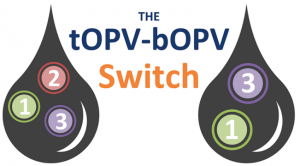Preparations for the Switch Accelerate
There are just eight weeks to go until the switch from trivalent to bivalent oral polio vaccine in April 2016

The world is fast approaching the largest globally synchronised project in the history of vaccines. Between 17 April and 1 May 2016, every country in with world using the oral polio vaccine (OPV) will switch from the trivalent vaccine (tOPV), which protects children against all three types of the virus, to the bivalent vaccine which protects children against type one and three. Now that type two wild polio has been declared eradicated, this is an essential part of the work that needs to be done to secure a polio-free world by phasing out oral polio vaccines to prevent future outbreaks of vaccine-derived polioviruses.
Find out more about why the switch needs to happen to stop vaccine derived polioviruses, how it will be done and the risk mitigation measures being put in place to help it run smoothly.
With just eight weeks to go until 17 April, preparations for the switch are gathering momentum, with several important activities underway:
In April, the oral polio vaccine currently used in routine immunization programmes, which protects children against all three strains of the virus, will be replaced by an oral vaccine which protects children against type one and three. As part of the preparations for the switch, countries are working to ensure that every health care and facility has a sufficient supply of the bivalent vaccine at least two weeks before their chosen switch date, so that they are ready to switch over completely to this vaccine with no interruption to their ability to protect children against polio
Each health care centre or facility that currently uses tOPV has been carefully planning to ensure that their supply of the vaccine didn’t take them far beyond the switch. However, where there is vaccine left over, WHO guidelines are being communicated to countries, districts and facilities so that these stocks can be disposed of after the switch dates. Once the switch has taken place, countries will need to carefully monitor every facility to check that they have stopped using and destroyed their stocks of tOPV.
Regional workshops are taking place in February and March, to help countries to finalise their plans. In addition to topics such as micro-planning, monitoring and validation, the workshops will explore challenges and gaps related to switch implementation, as well as potential solutions to address these issues.
As of 2 February 2016, 156 countries have introduced the inactivated polio vaccine (IPV) into their routine immunization systems, to help boost immunization against all strains of polio and to ensure that children have some baseline immunity against type two following the switch as a risk mitigation measure. This means that 81% of the global birth cohort are receiving IPV. All countries are expected to introduce IPV by the end of 2016; countries are being prioritised for introduction based on their level of risk for polio outbreaks.
With careful planning and thorough oversight, the switch will represent a huge achievement for the polio programme and will provide a basis for the eventual withdrawal of all OPV, following eradication of poliovirus types 1 and 3.
Read more about preparations for the switch here.













